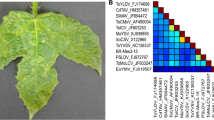Abstract
Monopartite begomoviral DNAs (2761 bp) were cloned and sequenced from field cotton, okra, and Sida alba, from Gezira, and field okra from Shambat. Comparison of the four apparent full-length begomoviral DNAs revealed 99.3–99.5% shared nucleotide (nt) identity, indicating that they are the same viral species, hereafter, referred to as Cotton leaf curl virus-Sudan (CLCuV-SD). Host range studies revealed that the field okra isolate of CLCuV-SD was whitefly-t ransmissible from okra to okra, M. parviflora, and hollyhock, but not to cotton. In contrast, the cotton isolate of CLCuV-SD infected cotton and hollyhock, but not okra. The genome of CLCuV-SD encodes six open reading frames (ORFs), and was most closely related to other monopartite begomoviruses of the Eastern Hemisphere. CLCuV-SD shared highest nucleotide sequence identity (95.5%) with Okra enation virus (OkEV), but was distantly related (≈74% nt sequence identity) to begomoviruses isolated from cotton in Pakistan. While extensive genomic regions of CLCuV-SD and OkEV are highly conserved (≈99% nt identity), nt sequence identity of the V1 ORF encoding the coat protein was uncharacteristically low (87.9%), suggesting a history of recombination. An analysis conducted with Sawyer's GENECONV program support the recombination hypothesis, indicating that the V1 ORF and a small segment of the intergenic region of CLCuV-SD and OkEV were derived from other begomoviruses. As a BLAST analysis failed to identify a prospective extant source of either V1 ORF, the parental viruses serving as CP donors remain undiscovered or are extinct.
Similar content being viewed by others
References
Brown J.K., FAO Plant Prot Bull 39, 5-23, 1990.
Kirkoatrick T.W., Bull Ent Res 12, 323-363, 1931.
Nour A.M. and Nour J.J., Emp Cott Gr Rev 70, 99-103, 1964.
Elnur E. and Abu Salih H.S., PANS 16, 121-131, 1970.
Mansoor S., Bedford I., Pinner M.S., Stanely J., and Markham P.G., J Botany 25, 105-107, 1993.
Nateshan H.M., Muniyappa V., Swanson M.M., and Harrison B.D., Ann Appl Biol 128, 233-244, 1996.
Abdel-Salam A.M., El-Shazly M.A., and Thouvenel J.C., Arab Biotechnol 1(1), 41-58, 1998.
Mansoor S., Khan S.H., Hussain M., Zafar Y., and Pinner M.S., Plant Dis 84, 101, 2000.
Harrison R.D., Liu Y.L., Khalid S., Hamed S., and Otim-Nape G.W., Ann Appl Biol 130, 61-75, 1997.
Sanz A.I., Fraile A., Garcia-Arenal F., Zhou X., and Robinson D.J., J Gen Virol 81, 1839-1849, 2000.
Idris A.M. and Brown J.K., Plant Dis 84, 809, 2000.
Doyle J.J. and Doyle J.L., Phytochem Bull 19, 11-15, 1987.
Ewing B., Hillier L., Wendl M.C., and Green P., Genome Res 8, 175-185, 1998.
Swofford D.L., PAUP * : Phylogenetic Analysis using Parsimony ( * and other Methods). Version 4. Sinauer Assoc. Sunderland, MA, 1998.
Sawyer S., Mol Biol Evol 6, 526-538, 1989.
Padidam M., Sawyer S., and Fauquet C.M., Virology 265, 218-225, 1999.
Arguello-Astorga G.R., Herrera-Estrella L., and Rivera-Bustamante R., Plant Mol Biol 26, 553-556, 1994.
Padidam M., Beachy R.N., and Fauquet C.F., J Gen Virol 76, 249-263, 1995.
Rybicki E.P., Arch Virol 139, 49-77, 1994.
Briddon R.W., Mansoor S., Bedford I.D., Pinner M.S., and Saunders K., Virology 285, 234-243, 2001.
Dry I.B., Rigden J.E., Krake L.R., Mullineaux P.M., and Rezaian A.M., J Gen Virol 74, 147-151, 1993.
Mayo M.A. and Pringle C.R., Virology 79, 649-657, 1998.
Briddon R.W., Mansoor S., Bedford I.D., Pinner M.S., and Markham P.G., Phytopathology 90, S9, 2000.
Author information
Authors and Affiliations
Corresponding author
Rights and permissions
About this article
Cite this article
Idris, A.M., Brown, J.K. Molecular Analysis of Cotton Leaf Curl Virus-Sudan Reveals an Evolutionary History of Recombination. Virus Genes 24, 249–256 (2002). https://doi.org/10.1023/A:1015380600089
Issue Date:
DOI: https://doi.org/10.1023/A:1015380600089




